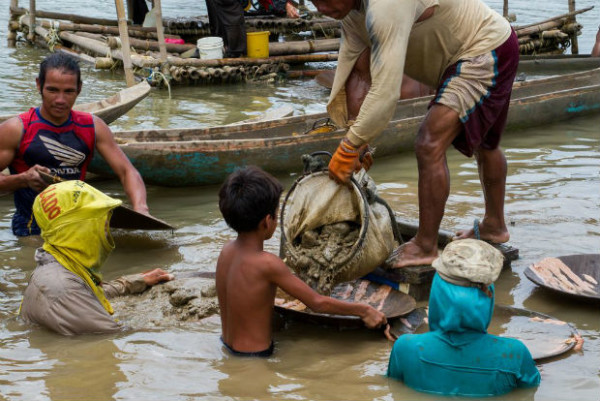In the dark, underwater
October 5, 2015 · By @inquirerdotnet for opinion.inquirer.net

“Peter,” 11, works at an underwater mining site in Santa Milagrosa, Jose Panganiban. PHOTO by Mark Z. Saludes/Human Rights Watch
It’s a specter that periodically rears its ugly head, drops briefly below the radar, and then reemerges with ever more horrifying dimensions: the employment of children in sweatshops, quarrying fields, even in illegal firecracker factories.
Last week, Human Rights Watch (HRW) assailed the Philippine government for failing to prevent young children from being forced to work in life-threatening conditions in illegal, small-scale gold mines. The New-York-based group issued a report in which it documented cases of children even as young as nine working in such mines, in violation of both Philippine and international labor laws.
“Filipino children are working in absolutely terrifying conditions in small-scale gold mines,” Juliane Kippenberg, HRW associate children’s rights director and author of the report, was quoted by The Associated Press as saying. “The Philippine government prohibits dangerous child labor, but has done very little to enforce the law.”
HRW sent researchers to the provinces of Camarines Norte and Masbate to interview the child miners, and came away with discoveries worthy of a horror movie. The children were constantly afraid of mine collapses and toiled in deep pits underwater in a method called “compressor mining.” This fearful practice required the children to dive and stay underwater for hours on end in dug-up shafts, receiving air from a tube attached to an air compressor.
The report described how the children suffered from “moments of fear” that they would drown. “I felt scared because it’s dark and deep,” said a 14-year-old boy. Another boy, 16, said: “Sometimes you have to make it up fast, especially if you have no air in your hose. It’s a normal thing. It’s happened to me.”
That doesn’t include the children’s complaints of health problems such as body pain, skin infections and spasms. Not surprising, considering that they use their bare hands to work with mercury, an extremely toxic substance. In one village—Malaya in Camarines Norte—the children have reported symptoms of mercury poisoning such as tremors.
According to the 2011 Survey on Children conducted by the National Statistics Office, 5.59 million Filipino children aged 5-17 were working, with 2.993 million slaving in hazardous conditions. Adding to this sad state of affairs is the fact that these children were working with the express consent of their parents. Instead of being in school, they were toiling to provide food and funds for their families. “We have to get to the root of child labor which is linked with poverty and lack of decent and productive work,” said Lawrence Jeff Johnson, country director for the International Labor Organization, which funded the 2011 survey. “While we strive to keep children in school and away from child labor, we need to ensure decent and productive work for parents and basic social protection for families.” That was all of four years ago.
We have harped often and at length on the horrors of child labor, including the use of children in cyberporn, in this space. That we are moved to continue to harp on it makes it abundantly clear that authorities have failed to stamp out the reprehensible practice.
Back in 2012 the Philippine government launched a new anti-child-labor campaign, with Labor Secretary Rosalinda Baldoz then promising “to do our utmost in making every barangay in the country with high child labor incidence child-labor-free.” Last February, she honored six villages in Sagada, Mountain Province, for reducing the incidence of child labor, notably in small-scale mining sites. Recently, in response to the HRW report, Baldoz told the AP of the government’s programs to keep children in school and give livelihoods to poor families, and to rescue child laborers and go after those who violate the laws enacted to protect them.
But as the HRW report proves, the government must do more because whatever it’s got going simply isn’t enough. The bottom line is that impoverished families have to be helped out of the trap they’re in as quickly as possible. The government must provide jobs for able-bodied parents so they do not send their children to a slow death (and punish those parents who insist on doing so), as well as education for the young, so that they may give themselves a chance for a bright, horror-free future.
LATEST






